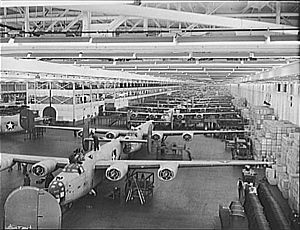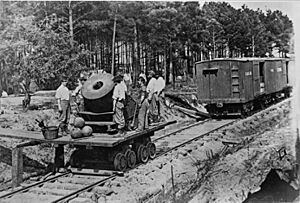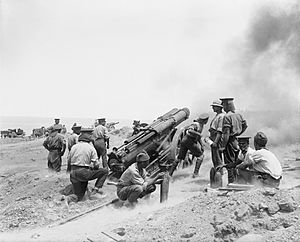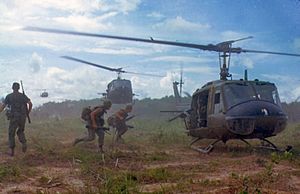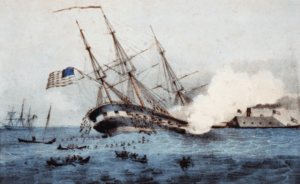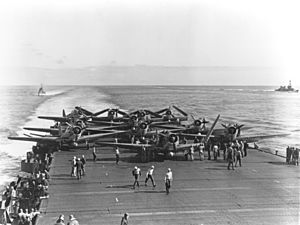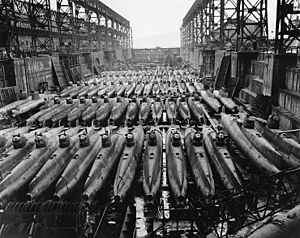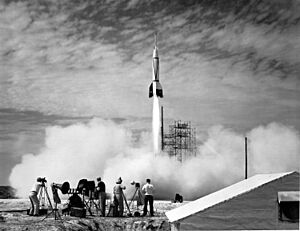Industrial warfare facts for kids
Industrial warfare is a time in history when wars changed a lot, roughly from the early 1800s to the start of the Atomic Age. This was when countries became industrialized. They could build huge armies, navies, and air forces.
During this time, armies used many new things. They had soldiers drafted from the public, fast ways to travel (like trains, ships, and planes), and new ways to communicate (like telegraphs and radios). The idea of "total war" also appeared. This meant using all a country's resources for the war. New weapons included better rifles, powerful artillery, chemical weapons, tanks, metal warships, submarines, and airplanes.
Contents
- Total War: Fighting with Everything You Have
- Conscription: Joining the Army by Law
- Transportation: Moving Armies and Supplies
- Communications: Sending Messages in War
- Land Warfare: Battles on the Ground
- Naval Warfare: Battles at Sea
- Aerial Warfare: Fighting in the Sky
- After World War II: The Nuclear Age
- Milestones: Key Moments in Industrial Warfare
- See Also
Total War: Fighting with Everything You Have
One big change in industrial warfare was the idea of "total war." This means a country uses all its people, money, and factories to win a war. It also means that civilians and their homes or factories can become targets. This is because destroying them hurts the enemy's ability to fight.
Total war grew in the 1800s because of industrialization. Countries had more money and resources. This meant wars could be much bigger and cost more. An industrialized country could choose how intense its warfare would be.
Warfare also became more about machines. Soldiers needed a lot of support, like food and weapons. This meant people at home had to help. Ideas like propaganda (to keep people's spirits up) and rationing (saving food and goods for the war) became common.
The American Civil War was an early example of total war. Union generals like Ulysses S. Grant and William Tecumseh Sherman believed they had to crush the South's ability to fight. Sherman used "scorched earth" tactics. This meant destroying civilian supplies and buildings as he marched through Georgia and the Carolinas. He aimed to break the South's will to fight.
Conscription: Joining the Army by Law
Conscription means that people are required to join the military. This allowed countries to create very large armies. For example, France used conscription to form "the nation in arms" under Napoleon Bonaparte. This army was much bigger than other European armies.
Conscription has often caused arguments in countries where people can vote. This is especially true when soldiers are sent to fight in other countries. For example, during World War I, there were big disagreements about conscription in Canada, Australia, and New Zealand. Later, many people protested against conscription for the Vietnam War in the 1960s.
Today, many developed countries rely more on technology and highly trained soldiers. Also, a big attack on most developed nations is unlikely. Because of this, mass conscription is less common now, but it could still happen in the future. Some countries, like Russia and Switzerland, still have armies mainly made up of conscripts.
Transportation: Moving Armies and Supplies
Land Travel
Before cars and trucks, soldiers traveled by wagons, horses, or by walking. Trains changed everything. They could move huge groups of soldiers, supplies, and equipment much faster. To stop the enemy, armies would destroy train tracks. During the American Civil War, General Sherman's men would twist heated rails around trees to make them unusable.
Cars and trucks changed war even more. The horse, which had been used in wars for thousands of years, was finally replaced. In both World War I and II, trucks carried soldiers and supplies. Cars and jeeps were used to scout enemy positions.
Tanks became very important in World War II. They were first invented in World War I to break through trenches and withstand machine gun fire. Tanks evolved from slow, lightly armored vehicles into fast, powerful war machines. They helped Germany conquer much of Europe. After tanks, new armored vehicles appeared, like armored personnel carriers (APCs) and amphibious vehicles (which can travel on land and water).
After World War II, armored transports kept getting better. Infantry fighting vehicles (IFVs) became popular. These are like APCs but have heavier weapons, like cannons. They can carry soldiers into battle and fight at the same time.
Sea Travel
Sealift means using cargo ships to move military equipment, soldiers, and supplies. It helps a country send its power far away. Countries can use their own military ships or hire civilian ships for this.
During World War I, the United States used many different kinds of ships. They bought, borrowed, or took over everything from small boats to large ocean liners. These ships carried American soldiers to Europe.
Air Travel
There are two main types of airlifts in war. A strategic airlift moves weapons, supplies, and people over very long distances. For example, from a base in one country to a base in another. Tactical airlifts move the same items but within a smaller area where fighting is happening. Tactical planes are usually smaller, slower, but can turn more easily.
Communications: Sending Messages in War
- Cryptography (secret codes)
- Homing pigeon/War pigeon (using pigeons to carry messages)
- Joint Army/Navy Phonetic Alphabet (like "Alpha, Bravo, Charlie")
- Message precedence (how urgent a message is)
- Semaphore (sending messages with flags)
- Signal Corps (military units for communication)
- Smoke signal
- Telegraphy (sending messages over wires)
Communication Equipment
- Aldis lamp (a light for sending Morse code)
- International maritime signal flags (flags used by ships to send messages)
Land Warfare: Battles on the Ground
Land warfare happens on land. It can take place in cities, cold arctic areas, or mountains.
The early 1800s were peaceful in Europe, and industries grew a lot. This brought many new technologies that changed land warfare. Fighting moved from close-up, person-to-person combat to fighting from far away. The Crimean War (1853–1856) saw the first use of trenches, long-range artillery, railroads, and the telegraph.
In World War I (1914–1918), machine guns, barbed wire, chemical weapons, and landmines appeared. This led to deadly trench warfare, where armies dug long ditches and fought from them. Tanks finally helped armies move past these stalemates late in World War I.
One big change was moving away from large groups of soldiers firing together. New, more accurate rifles allowed soldiers to target enemies specifically. This meant smaller, more flexible groups of soldiers could be used.
New Technologies for Land Warfare
Rifling means adding spiral grooves inside a gun barrel. These grooves make the bullet spin, which improves its range and accuracy. Once rifling became common, the "rifle" was invented. Rifles allowed soldiers to aim at specific enemies, rather than just firing into a crowd. This made smaller groups of soldiers more effective.
Artillery are large guns that fire big shells a long distance. Early artillery was slow and heavy, mostly used for attacking or defending castles. With industrialization, lighter, more powerful, and accurate artillery was made. This led to "field artillery," which could support troops directly on the battlefield.
Machine guns are guns that fire automatically. In this era, they were usually mounted on stands. Early machine guns, like the Gatling gun, were hand-cranked. Later, truly automatic machine guns, like the Maxim gun, were invented. Machine guns were great at breaking up enemy formations, especially when enemies attacked in dense groups. This, along with better artillery, completely changed how battles were fought.
Static Defenses: Strongholds that Don't Move
Static defenses are like modern versions of medieval castles. As artillery became more powerful, these defenses were built with thicker stone, then concrete and steel. Some even had cannons on turrets that could turn. France built a huge underground defense line called the Maginot Line between World War I and II. It was supposed to stop German tanks, but the Germans simply went around it through Belgium in 1940.
Temporary Fortifications: Digging In
As rifles and artillery could kill enemies from farther away, soldiers started digging temporary defenses. These included the massive trenches used in World War I and smaller "fox holes" for individual soldiers, which became common in World War II.
Maneuver Warfare: Moving Fast to Win
Maneuver warfare means moving quickly to outsmart the enemy. It existed before, with soldiers marching or cavalry on horses. But it really took off with tanks and armored vehicles that could move over rough ground. Germany first used this in World War II with "Blitzkrieg" or "lightning war." Whole armies moved very fast using tanks and armored vehicles.
During the war, soldiers were also dropped behind enemy lines by parachute. After World War II, helicopters made it even easier to transport troops by air.
- Armoured warfare (fighting with tanks and armored vehicles)
- Blitzkrieg (lightning war)
- Deep operations (attacking far behind enemy lines)
Ironclads and Dreadnoughts: The Rise of Metal Ships
After the Napoleonic Wars, new technologies changed ships. Steam power for ships appeared in the 1810s. Better metalwork led to bigger, deadlier guns. When explosive shells could destroy a wooden ship with one hit, ships needed iron armor. This led to "ironclads."
The famous battle between the CSS Virginia and USS Monitor in the American Civil War was a duel between ironclads. It showed that metal ships were much better than wooden ones. After this, countries around the world quickly started building iron fleets.
In the late 1800s, naval warfare changed again because of Alfred Thayer Mahan's book, The Influence of Sea Power upon History. Mahan argued that controlling the sea was key to winning wars. He said that large fleets of powerful "capital ships" were the best way to do this. His ideas led to a naval arms race before World War I.
By the end of the century, the modern battleship began to appear. These were steel-armored ships powered by steam. They had many large guns in turrets along the ship's center. The ultimate design was the HMS Dreadnought in 1906. It had only large guns, powerful enough to sink any other ship of its time.
The Russo-Japanese War in 1905, especially the Battle of Tsushima, was the first big test of these new ships. Japan won a huge victory. World War I saw the British Royal Navy fight the German navy in the Battle of Jutland in 1916. After the war, many countries agreed to limit the size of their fleets.
Tensions in the 1930s led to building even bigger ships. The Japanese battleship Yamato, launched in 1941, was enormous and had 18-inch guns. This was the peak of "big gun" warfare. Airplanes then started to play a bigger role, and by the 1960s, battleships had almost disappeared.
Aircraft Carriers: Floating Airfields
Between the two World Wars, the first aircraft carriers appeared. These were ships with a flat deck for planes to take off and land. The first true "flat-top" carrier was HMS Argus, launched in 1917.
By World War II, aircraft carriers usually carried three types of planes: torpedo bombers (for bombing and scouting), dive bombers (also for scouting), and fighters (to protect the fleet and escort bombers). These planes were small because of limited space on the carriers. The British Royal Navy showed the power of naval air power at the Battle of Taranto in 1940. This set the stage for Japan's larger attack on Pearl Harbor the next year.
Two days after Pearl Harbor, the sinking of HMS Prince of Wales and HMS Repulse showed that battleships were no longer the most powerful ships. After World War II, aircraft carriers remained key to navies. In the 1950s, they launched jets and became huge "Supercarriers," some weighing 100,000 tons.
Submarines: Silent Hunters Beneath the Waves
Submarines also became very important. They could travel underwater, first for short dives, then for weeks or months powered by nuclear reactors. The first successful submarine attack in war was in 1864. The Confederate submarine H.L. Hunley sank the USS Housatonic.
In both World Wars, submarines mainly sank merchant ships using torpedoes. They also attacked warships. All countries used "unrestricted submarine warfare," sinking merchant ships without warning. After World War II, during the Cold War, ballistic missile submarines were developed. These carried dozens of nuclear missiles, ready to launch if another country attacked.
Aerial Warfare: Fighting in the Sky
Airplanes were first used in war during the Italo-Turkish War in 1911. Italians used them for scouting and bombing. In World War I, both sides used balloons and planes to scout and direct artillery fire. Pilots started attacking enemy planes and balloons, first with small guns, then with machine guns mounted on their aircraft. Planes were also used for bombing and dropping leaflets.
Germany used Zeppelins (large airships) to drop bombs on Britain. By the end of World War I, planes had become specialized. There were bombers, fighter planes, and surveillance planes. Most were biplanes (with two sets of wings) made of wood and canvas.
Between 1918 and 1939, airplane technology improved very fast. Metal-framed monoplanes (with one set of wings) replaced biplanes. Speeds tripled, and planes could fly much higher. Bombers could carry more bombs and fly farther.
Some thinkers believed that air power would win future wars. They thought that destroying the enemy's factories and cities from the air would be enough. This idea was called strategic bombing. Others thought air power could sink naval fleets. In 1921, Billy Mitchell proved this by sinking a former German battleship with bombs from planes.
During World War II, there was a debate between strategic bombing and tactical bombing. Strategic bombing targeted factories, railroads, oil refineries, and cities. This needed large, heavy bombers. Tactical bombing focused on enemy soldiers, command centers, airfields, and supply dumps. This used smaller attack planes that flew low over the battlefield.
Early in World War II, Germany's Luftwaffe (air force) focused on tactical bombing. They used many Ju 87 Stukas as "flying artillery" to support their fast ground attacks. This helped Germany succeed in the Battle of France. Air support was also important in amphibious warfare, where aircraft carriers helped soldiers landing on beaches.
Strategic bombing in World War II was huge. In 1940, Germany tried to force Britain to surrender by attacking its airfields, factories, and cities in The Blitz. This was the Battle of Britain, the first major battle decided mostly by air power. Later campaigns involved thousands of planes dropping tons of bombs on single cities.
After World War II, military aviation focused on the Cold War. Jet engines made planes much faster and able to fly higher. Before intercontinental ballistic missiles (ICBMs), major powers used high-altitude bombers to deliver nuclear weapons. Countries worked hard to develop better bombers and fighters to intercept them. The idea of "air superiority" (controlling the sky) became very important.
After World War II: The Nuclear Age
With nuclear weapons, a full-scale war could destroy the whole world. So, conflicts since World War II have been smaller, often "proxy wars." In these wars, big countries supported different sides in local conflicts. They used "conventional weapons" (non-nuclear) and tactics like asymmetric warfare (where weaker sides use unusual methods).
Nuclear Warfare: The Ultimate Weapon
Nuclear weapons were first used at the end of World War II, when atomic bombs were dropped on Hiroshima and Nagasaki. This was the only time nuclear weapons have been used in combat. For about ten years after World War II, the United States and later the Soviet Union built up forces of bombers that could attack any enemy from their own countries.
Before the Soviet Union had strong missiles, Western countries thought about using many smaller nuclear weapons in battles. But it was believed that if the USSR used any nuclear weapon against cities, the US would use its own strategic nuclear weapons.
A big change happened with the intercontinental ballistic missile (ICBM). The Soviet Union first successfully tested one in the late 1950s. Missiles were cheaper than bombers to deliver a warhead. Also, at the time, ICBMs flew so high and fast that they couldn't be stopped.
In the 1960s, another big change was the submarine-based nuclear missile (SLBM). Military thinkers believed these would make nuclear war less likely. This is because a surprise attack couldn't destroy all nuclear weapons if some were hidden on submarines underwater.
The Cold War: A Standoff of Superpowers
Since World War II, major industrial nations haven't fought a huge war. This is because nuclear weapons are so destructive that winning such a war would be like losing. A total war with nuclear weapons wouldn't take years, but minutes. These weapons are kept ready with smaller defense budgets during peacetime.
By the late 1950s, the Cold War was a standoff between the Western World and the Soviet Union. Both sides had thousands of nuclear weapons aimed at each other. This situation was called Mutually Assured Destruction (MAD). The idea was that if one side attacked with nuclear weapons, the other would strike back. This would cause millions of deaths.
During the Cold War, the superpowers avoided direct fighting. They knew it could quickly lead to nuclear war. Instead, they fought through proxy wars. They supported their allies in conflicts against forces linked to the other superpower. Examples include the Korean War, the Vietnam War, and the Soviet invasion of Afghanistan.
21st Century Warfare
Recent conflicts, like the Russo-Ukrainian War, show that industrial warfare is still important. Modern wars use a lot of equipment, vehicles, and ammunition. This means countries still need a large industrial base to keep their armies supplied.
Milestones: Key Moments in Industrial Warfare
| Year | Battle | Country | Significance |
|---|---|---|---|
| 1854–1855 | Siege of Sevastopol | First use of the telegraph in battle. | |
| 1859 | Austro-Sardinian War | First major use of railroads for moving armies. | |
| 1861 | First Battle of Bull Run | First battle where railroads played a key role. | |
| 1862 | Battle of Hampton Roads | First fight between two powered iron-covered warships. | |
| 1864–1865 | Siege of Petersburg | First example of modern trench warfare. | |
| 1898 | Spanish–American War | Many steel battleships used in a naval conflict. | |
| 1905 | Battle of Tsushima | A major battle between steel-covered warships. | |
| 1911–1912 | Italo-Turkish War | First use of airplanes in combat. | |
| 1914 | First Battle of the Marne | First large use of motorised infantry (soldiers moved by vehicles). | |
| 1914–1918 | First Battle of the Atlantic | First major campaign of submarine warfare. | |
| 1915 | Second Battle of Ypres | First large use of chemical weapons in battle. | |
| 1916 | Battle of Verdun | A peak of fixed fortification warfare. | |
| 1917 | Battle of Cambrai | First successful use of many tanks in battle. | |
| 1925 | Rif War | First modern amphibious assault using tanks and aircraft. | |
| 1937 | Bombing of Guernica | First major use of terror bombing (bombing civilians to scare them). | |
| 1937 | Battle of El Mazuco | First major use of carpet bombing (dropping many bombs over an area) against a military target. | |
| 1940 | Battle of Britain | First major battle fought only in the air. | |
| 1940 | Battle of Taranto | First naval battle where one side only used aircraft. | |
| 1941 | Battle of Crete | First major battle where one side only used airborne forces (soldiers dropped by air). | |
| 1941 | Operation Barbarossa | High point of Blitzkrieg warfare. Largest invasion in history. | |
| 1942 | Battle of the Coral Sea | First naval battle where ships did not see or fire directly at each other. | |
| 1942 | Battle of Midway | A very important battle between aircraft carriers. | |
| 1942 | Battle of Stalingrad | Largest single battle in history. A key battle of World War II. | |
| 1942 | Battle of Guadalcanal | First major air-land-sea campaign in history. | |
| 1943 | Battle of Kursk | Largest tank battle in history. | |
| 1944 | Normandy Invasion | Largest seaborne invasion in history. | |
| 1944 | Battle of Leyte Gulf | Largest naval battle in history. |
See Also
- Mobilization (getting ready for war)
- Trench warfare
- Unconditional surrender (giving up completely)
- World war
Material aspects:
- Arms race (countries building more weapons than others)
- Economic warfare (using money and trade to hurt an enemy)
- Home front (people at home supporting the war)
- Mass production (making many things quickly)
- Total war
- War economy (how a country's money and resources are used for war)
- War effort (all the things a country does to win a war)
Specific:
- Cold War
- Curtis LeMay (a famous air force general)
- Technology during World War I
- Technology during World War II
- Technological escalation during World War II (weapons getting more powerful during WWII)
- Unrestricted Warfare (a book about modern warfare)


